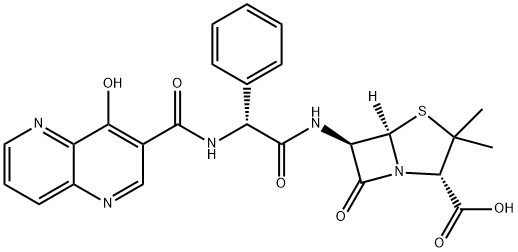
APALCILLIN
- Product NameAPALCILLIN
- CAS63469-19-2
- MFC25H23N5O6S
- MW521.54
- EINECS221-488-3
- MOL File63469-19-2.mol
Usage And Synthesis
ChEBI: Apalcillin is a penicillin and a 1,5-naphthyridine derivative. It is a conjugate acid of an apalcillin(1-).
(a) Preparation of 6-D-α-aminobenzylpenicillin phenacyl ester: To a
suspension of phenacyl 6-aminopenicillanate hydrochloride (1.85 g) and Dphenylglycyl
chloride hydrochloride (1.29 g) in dichloromethane (20 ml),
sodium bicarbonate (1.05 g) was added, and the resultant mixture was stirred while cooling with ice for 6 hours. The reaction mixture was filtered to
eliminate the by-produced sodium chloride. The filtrate was admixed with
isopropanol and concentrated under reduced pressure by the aid of a rotary
evaporator. After the evaporation of dichloromethane, the precipitate was
collected by filtration to give the objective compound in the form of the
hydrochloride (2.19 g) MP 142° to 148°C (decomposition).
(b) Preparation of D-α-(4-hydroxy-1,5-naphthyridine-3- carbonamido)benzylpenicillin: To a solution of 6-D-α-aminobenzylpenicillin phenacyl ester (hydrochloride) (2.01 g) and triethylamine (0.808 g) in dimethylformamide (20 ml), 4-hydroxy-1,5-naphthyridine-3-carboxylic acid Nsuccinimide ester [MP 310° to 311°C (decomposition)] (1.15 g) was added while cooling with ice, and the resultant mixture was stirred for 1 hour. Stirring was further continued at room temperature for 2 hours. After cooling with ice, 1% sodium bicarbonate solution (100 ml) was added thereto. The precipitated crystals were collected by filtration, washed with water and dried over phosphorus pentoxide to give D-(α-4-hydroxy-1,5-naphthyridine-3- carboxamido)benzylpenicillin phenacyl ester (2.17 g).
The above product was dissolved in dimethylformamide (65 ml), sodium thiophenoxide (0.89 g) was added thereto, and the resultant mixture was stirred at room temperature for 1 hour. To the resultant mixture, acetone (650 ml) was added, and the separated crystals were collected by filtration and washed with acetone and ether in order to give the objective compound in the form of the sodium salt (1.3 g).
In the above procedure, the use of 4-hydroxy-1,5-naphthyridine-3-carbonyl chloride in place of 4-hydroxy-1,5-naphthyridine-3-carboxylic acid Nsuccinimide ester can also afford the same objective compound as above. The use of sodium thio-n-propoxide in place of sodium thiophenoxide can also give the objective compound in the form of the sodium salt.
(b) Preparation of D-α-(4-hydroxy-1,5-naphthyridine-3- carbonamido)benzylpenicillin: To a solution of 6-D-α-aminobenzylpenicillin phenacyl ester (hydrochloride) (2.01 g) and triethylamine (0.808 g) in dimethylformamide (20 ml), 4-hydroxy-1,5-naphthyridine-3-carboxylic acid Nsuccinimide ester [MP 310° to 311°C (decomposition)] (1.15 g) was added while cooling with ice, and the resultant mixture was stirred for 1 hour. Stirring was further continued at room temperature for 2 hours. After cooling with ice, 1% sodium bicarbonate solution (100 ml) was added thereto. The precipitated crystals were collected by filtration, washed with water and dried over phosphorus pentoxide to give D-(α-4-hydroxy-1,5-naphthyridine-3- carboxamido)benzylpenicillin phenacyl ester (2.17 g).
The above product was dissolved in dimethylformamide (65 ml), sodium thiophenoxide (0.89 g) was added thereto, and the resultant mixture was stirred at room temperature for 1 hour. To the resultant mixture, acetone (650 ml) was added, and the separated crystals were collected by filtration and washed with acetone and ether in order to give the objective compound in the form of the sodium salt (1.3 g).
In the above procedure, the use of 4-hydroxy-1,5-naphthyridine-3-carbonyl chloride in place of 4-hydroxy-1,5-naphthyridine-3-carboxylic acid Nsuccinimide ester can also afford the same objective compound as above. The use of sodium thio-n-propoxide in place of sodium thiophenoxide can also give the objective compound in the form of the sodium salt.
A semisynthetic acylaminopenicillin supplied as the sodium
salt for parenteral administration. The antibacterial spectrum
and toxicity profile are similar to those of the acylureidopenicillins.
It is relatively labile to many β-lactamases, including
the common TEM plasmid-mediated enzyme. It has very
limited commercial availability.
Preparation Products And Raw materials
PROMPT×
PROMPT
The What'sApp is temporarily not supported in mainland China
The What'sApp is temporarily not supported in mainland China
Cancel
Determine